
At the weekend, I finished the documentation for two strategy tools that I developed and have been working with for some time in my consulting projects, in training courses and as a lecturer. And people are always impressed. However, "tool" here doesn't mean just any piece of software, but a method in each case. Specifically, we are talking about the "FISH model" and the "Content RADAR". The aim of both tools is the same: Namely, to create content in a more structured and methodical way. On the one hand, this provides a clear orientation and thus enormous security during planning and, on the other hand, a good basis for a later performance analysis. I hope I'm conveying the idea as well here as I do "live".
One problem that I observe time and again with clients (but also with many agencies) is that they come up with lots of ideas about what content they can create. The good ones manage to organize the content into topics in addition to defining post types (e.g. Facebook post, blog article or Instagram image). And the really good ones define personas, which are sometimes more, sometimes less elaborately researched and described. But when it comes to implementation, there is usually only one thing that counts: your own gut feeling and what you "somehow like" afterwards. At the latest when it comes to approval, because the customer or manager has no other standards by which to judge the quality of the content.
Here are two central charts for both tools, the FISH model on the left and Content RADAR on the right:
The FISH model
The basic idea behind the FISH model is that content must fulfill certain tasks: both for the company (which has to finance it) and for the consumer (who would otherwise not read it). However, mixing tasks can interfere with each other, e.g. "generating leads" and "building trust". The more clearly content pursues each individual task, the better it will perform that task.
Strategic content marketing
"Strategic content marketing" means building a system in which the individual pieces of content play "as a team", according to a specific game system and with distributed tasks - but always together. The FISH model now defines different types of content, all of which should fulfill different tasks and which must therefore also be implemented differently.
The Content RADAR
A second model is the Content RADAR, which adds a second dimension, so to speak. While the FISH model focuses primarily on the benefits for the company, the Content RADAR represents the benefits for the reader. If you combine both models, this results in a very precise blueprint for the implementation of the content - and that is an ingenious orientation aid.
So here are the slides first, with explanations below.
Follow content is content that is designed to interest people so much that they want more of it. This allows you to retain them and gain "access" to them. Lars Cords, Chief Content Officer of the Scholz & Friends Group, refers to this type of content as "Scheherazade content". The daughter of the vizier from "One Thousand and One Nights", Scheherazade, always managed to save her head every day because the Persian king wanted to hear the continuation of her story. Rubrics, series and serials are suitable here on the one hand, and storytelling on the other. Images also play an important role here.
The key here is to offer many ways for the customer to subscribe to the content, for example via a "Like" on Facebook or a subscription to a newsletter or a "Follow" on Twitter. This is particularly important for building reach, which we will come back to in part three. This type of content should be published on channels where people are in "consumption mode", especially on Facebook or in a "magazine".
Inbound content. Here you offer very elaborate, exclusive content with high utility value. However, the main aim is for the reader to request the content and leave their email address in return. This generates a "lead" that your sales department can use later. Studies or whitepapers are very suitable here, but the topic must also provide this. Inbound content plays a very different role for companies: for some, especially sales-oriented ones, it is indispensable. For others, who are more concerned with image, it hardly plays a role.
And it has something in common with all the others: it should be easy to find in search engines like "search content", it should be attention-grabbing like "highlight content", and ideally it should make you want more like "follow content"
Search and sales content aims to serve the answers to questions that are actually asked. The benefit for your company is that you will be found on the one hand and build your reputation on the other. Avoid giving answers to questions that nobody has asked! Unlike with follow content, storytelling tends to be a hindrance here, and images generally play a subordinate role.
Above all, search content must be optimized for keywords, both for Google and for the reader, who must quickly recognize that this is where they will find the answer to the question or information they are looking for. In contrast to follow or highlight content, the headline must also be factual and informative rather than creative. And remember: search content is not just for Google. People also search in many other places, for example YouTube, Slideshare, Amazon and also on your website!
Highlight content is there to attract attention. It should inspire the target groups, but the benefit for you is that they spread the content further! These are the big campaigns, the viral videos, and they should also be promoted more. They are usually very expensive, both in terms of production and seeding costs, but they are very helpful in building up a large reach.
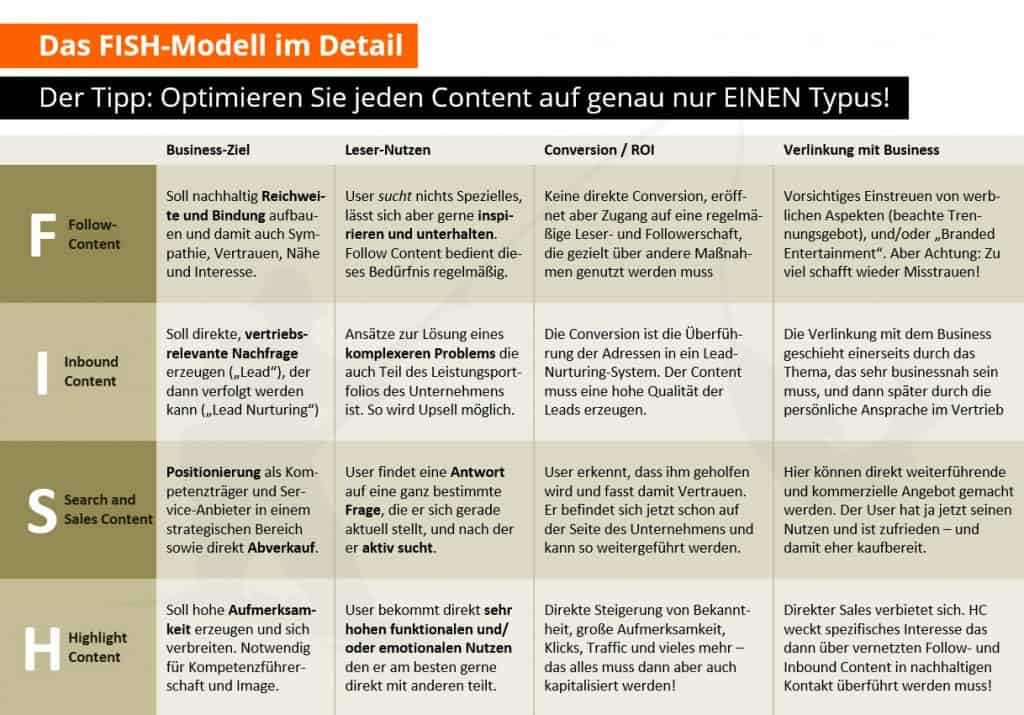
The importance of SEO
And what also becomes clear here is the different meaning of SEO! This was one of the most important findings for me during development, i.e. in relation to the many discussions about the importance of SEO! My conclusion: SEO is still ENORMOUSLY important for inbound and search content, quasi mission-critical. For follow and highlight content, however, SEO plays virtually no role!
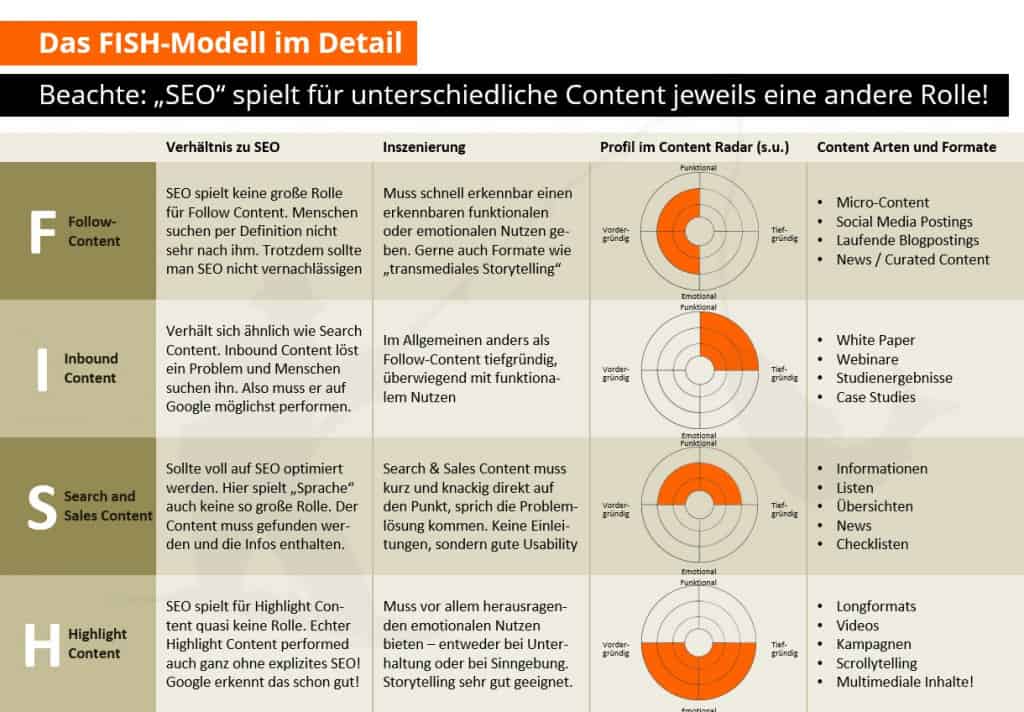
My tip:
Assign your content to a content type according to the FISH model and then design it consistently according to the specifications. The categories also result in different requirements for the content: search content is generally the simplest, follow content must be at least above average and highlight content must always be exceptional. And make sure you have a balanced mix: always focus on follow and search content, supplemented by the targeted use of highlight and, if necessary, inbound content.
And combine content types within your subject areas! This is time-consuming but much more efficient because you don't have to make any compromises. This is because the content types are sometimes contradictory: follow and highlight content should be in storytelling format, for example, whereas search content must get to the point immediately (!). And search content should tend to be short and concise, whereas inbound content needs to be more complete.
The Content RADAR
The Content Radar makes a distinction between emotional or functional content on the one hand, and superficial or in-depth content on the other. Both distinctions are very important because content works differently in each area. "Emotional/functional" focuses on the benefit that we convey to the reader. Above all, do they "learn" something? Do they take something away from the text that they can use later? Will they be better informed? Or do we primarily want to convey an emotion that may not have any functional value, but is often even perceived as more valuable?
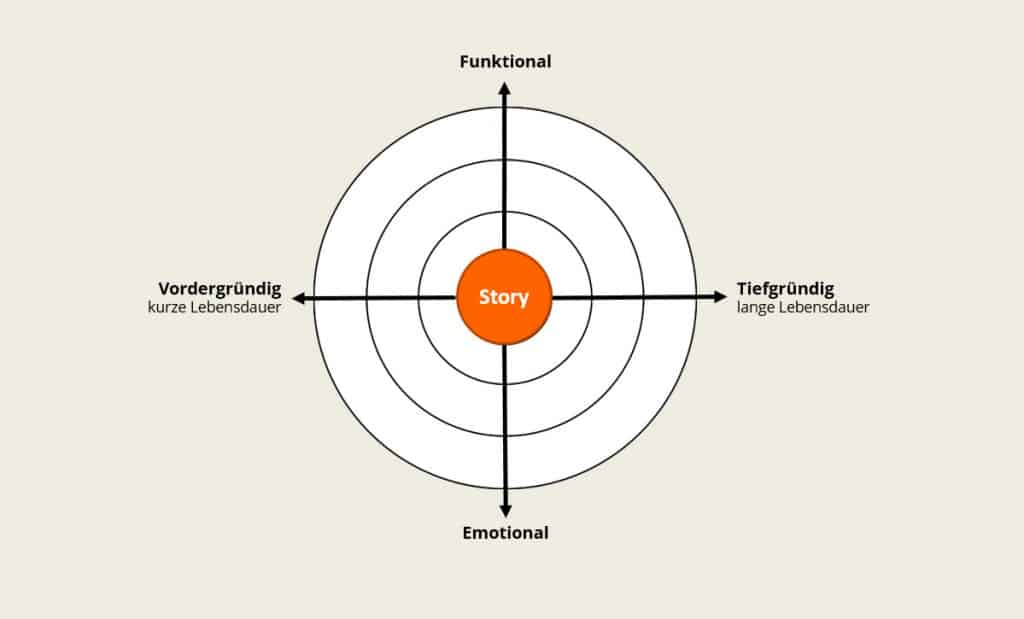
And "superficial/profound" refers to the question of how much time the reader should take. This primarily depends on how interested they are. If there is little or only superficial interest, the content must be short and snappy. Otherwise the reader will lose interest. However, if the reader is interested and is willing to invest time, then superficial content will not satisfy them. Here we have to deliver something profound, and it even has to be long. The reader will always want more.
In this way, from the reader's perspective, four areas of benefit emerge for which different requirements and rules apply:
- News/Information ("I know")
- Knowledge/enabling ("I have learned something")
- Entertainment/fun ("I enjoy it")
- Relationship/meaning ("I have understood it")
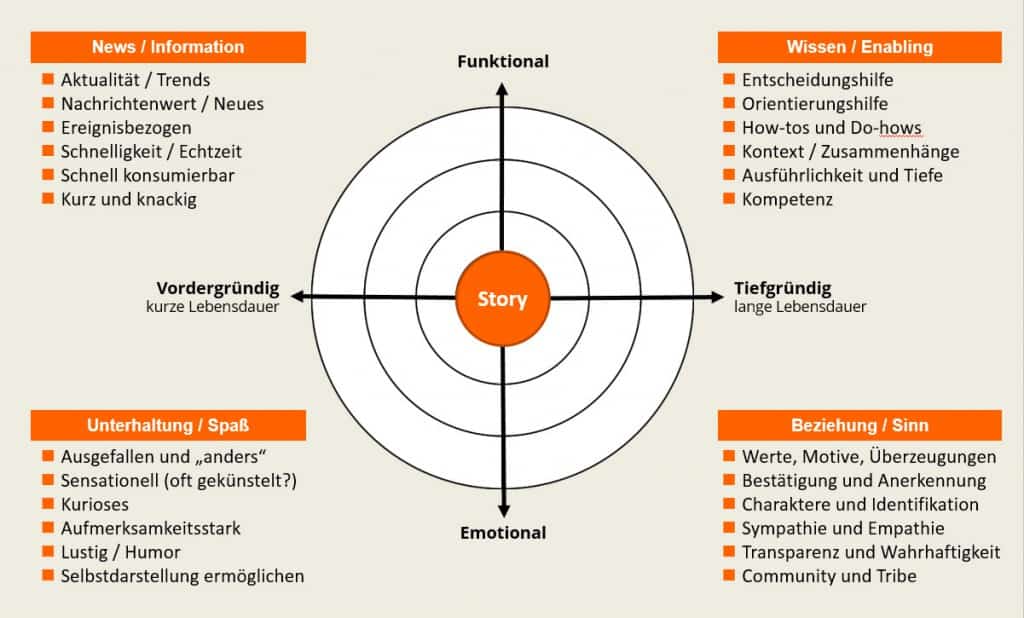
The "News/Information" section focuses on topicality and trends. The news value is important here; speed, topicality and exclusivity are what count. The " Knowledge/Enabling" section primarily provides orientation and decision-making support, and the depth of information plays an important role here. This area is particularly suitable if you are striving for competence leadership in a specific area. In the " Relationship/meaning" area, the main focus is on conveying meaning, making motives clear and understanding motivations. And the area of " entertainment/fun" probably goes without saying.
I recommend setting a strategic focus on one of these areas. We determine for our customers whether we just want to be "me too", "above average" or "leading" in each of the four areas. And this then defines the demands we have to place on production. This also has the aim of focusing resources in order to be "competitive" in one area of activity. Because that's what we are with our content: in competition. We have to be perceived as "better" by Google and then also by the user: the quality of the overall content available determines the standard of the content of each individual company. And these qualities result in different formats for each purpose, but also clear strategic recommendations for individual formats:
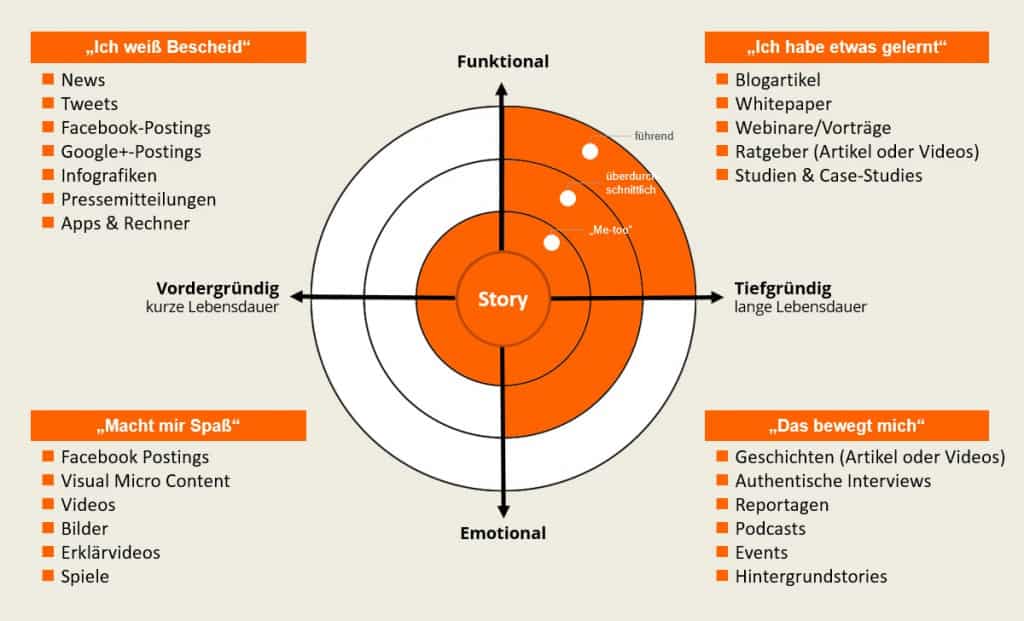
Curved magazine, for example, focuses primarily on news/information and knowledge/enabling. Here you can find the latest news about smartphones, tablets and gadgets, as well as in-depth tests and guides to help you find your way around. Entertainment and relationships, on the other hand, hardly feature at all. Red Bull's Red Bulletin, on the other hand, is a good example of entertainment. The magazine is primarily about fun, and this is enriched with some news and stories about people. And the content of "Always" ("Like a girl") or "Dove" ("Beauty Sketches") focuses primarily on "relationship", they convey a deeper meaning ("Significance"), for example by advocating for girls or "normal-built women".
The tip:
Assign your topic ideas to a benefit field and try to be at least "above average" in at least one of the benefit fields. And then choose a "format" for your topic accordingly, for example a post, an article or a video. For example, if you want to position yourself as a competence leader in your field, then focus on the area of "knowledge/enabling". And if you have addressed the "I" in the FISH model, such as "inbound", this results in the white paper that you market via a landing page. Or you can also use "follow content" and produce a series of how-to videos that you can use to communicate your expertise and generate subscribers for your YouTube channel.
And what do you think?
I hope that these two tools can also help you in your work. If you have any questions: Just write them in the comments below. Otherwise, I look forward to any feedback, especially if this article has annoyed you. I would be very happy to hear why. P.S. Oh yes: There is a software tool after all. Namely Scompler. We are developing this in parallel to all these methods. Then it will work much better with "strategic content marketing".
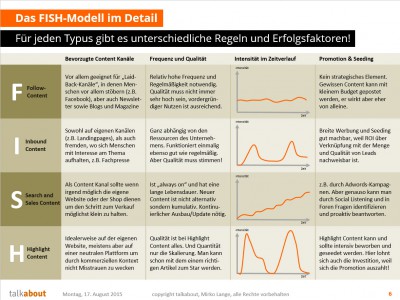
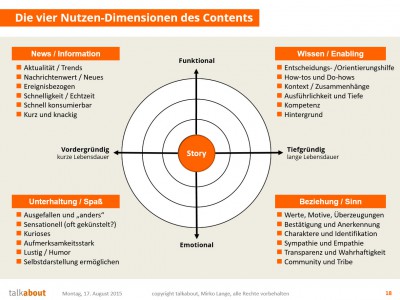
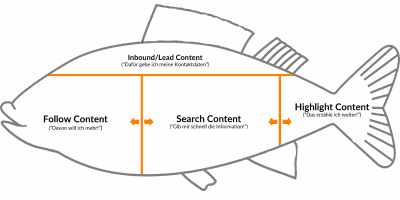

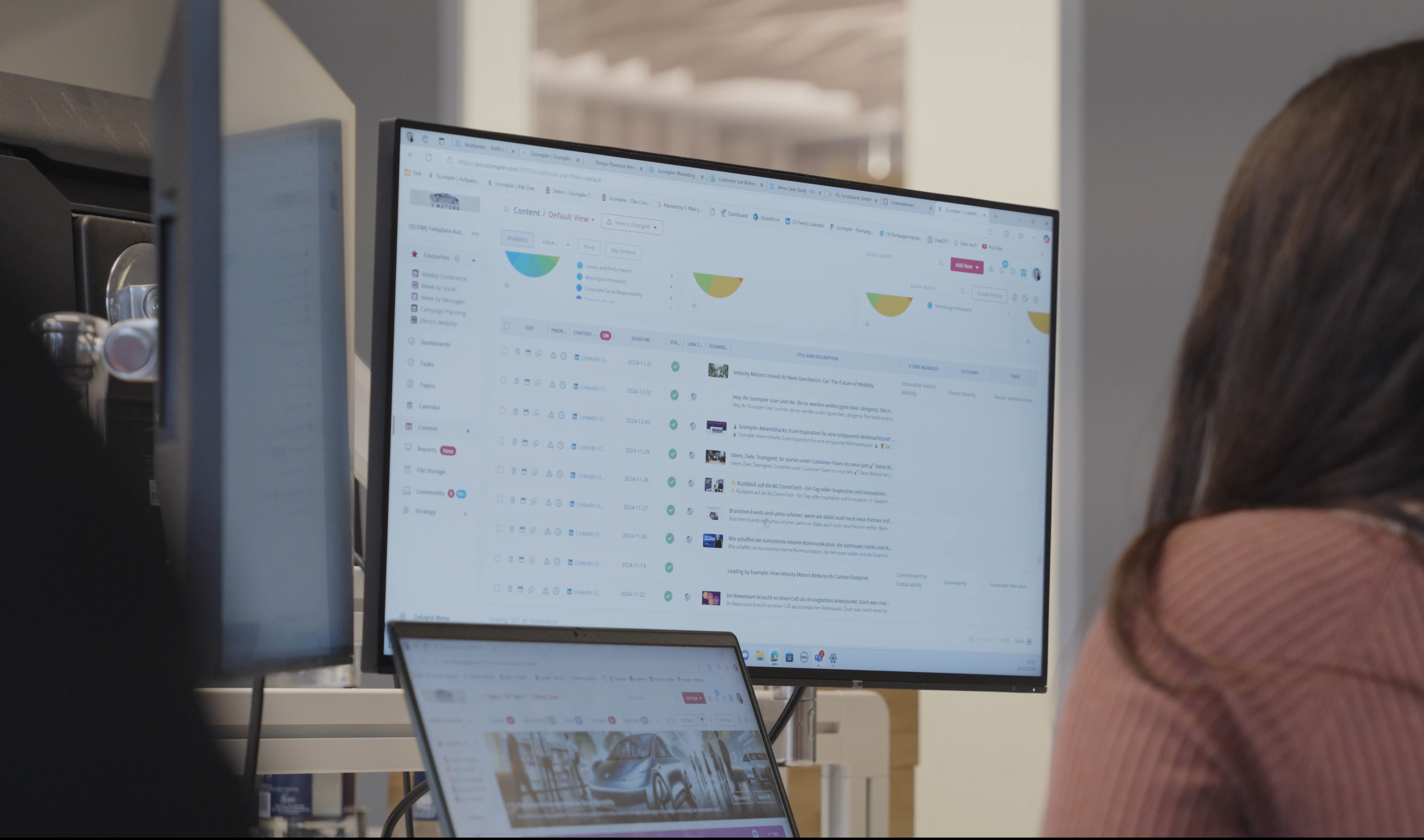

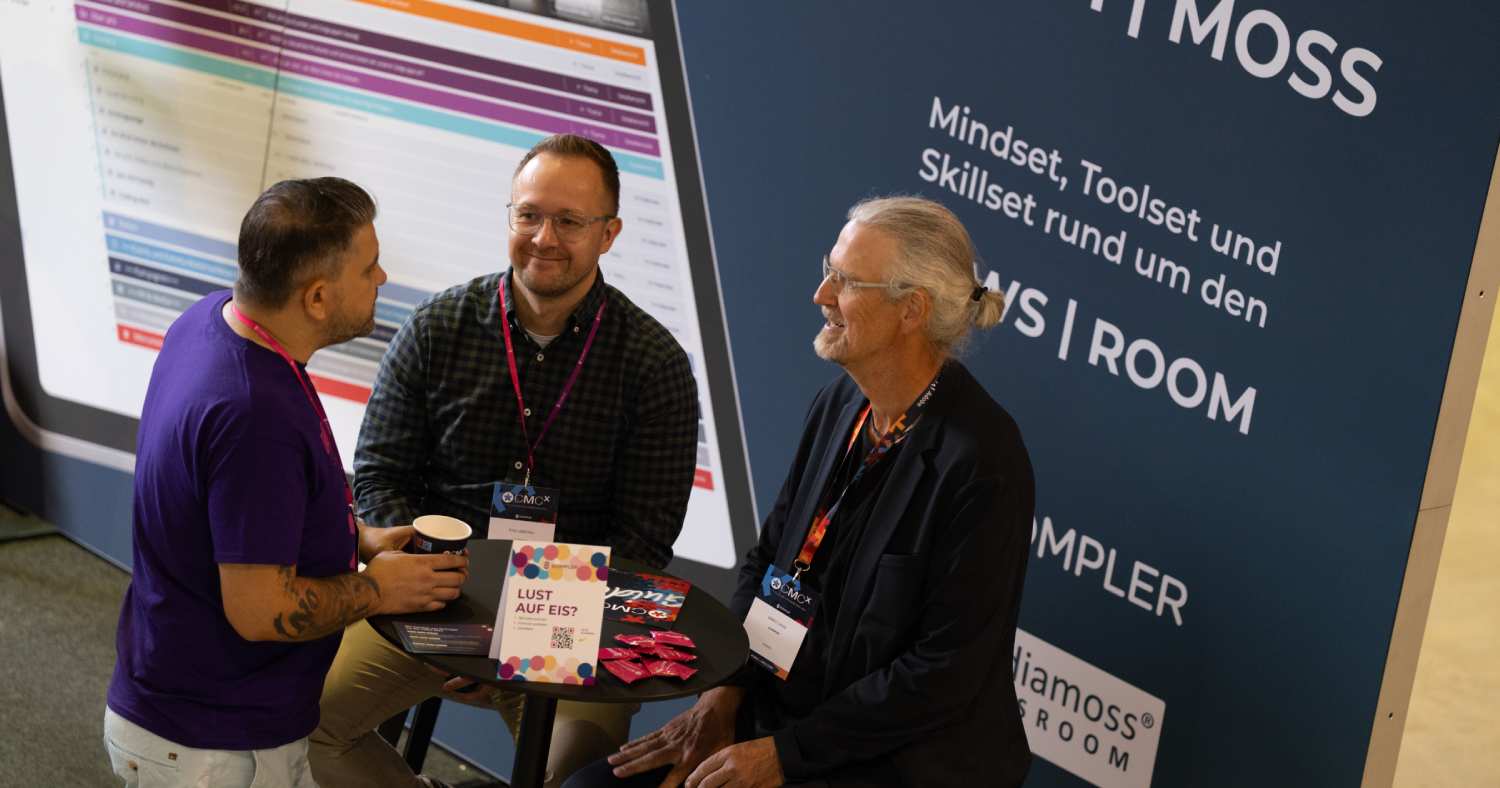
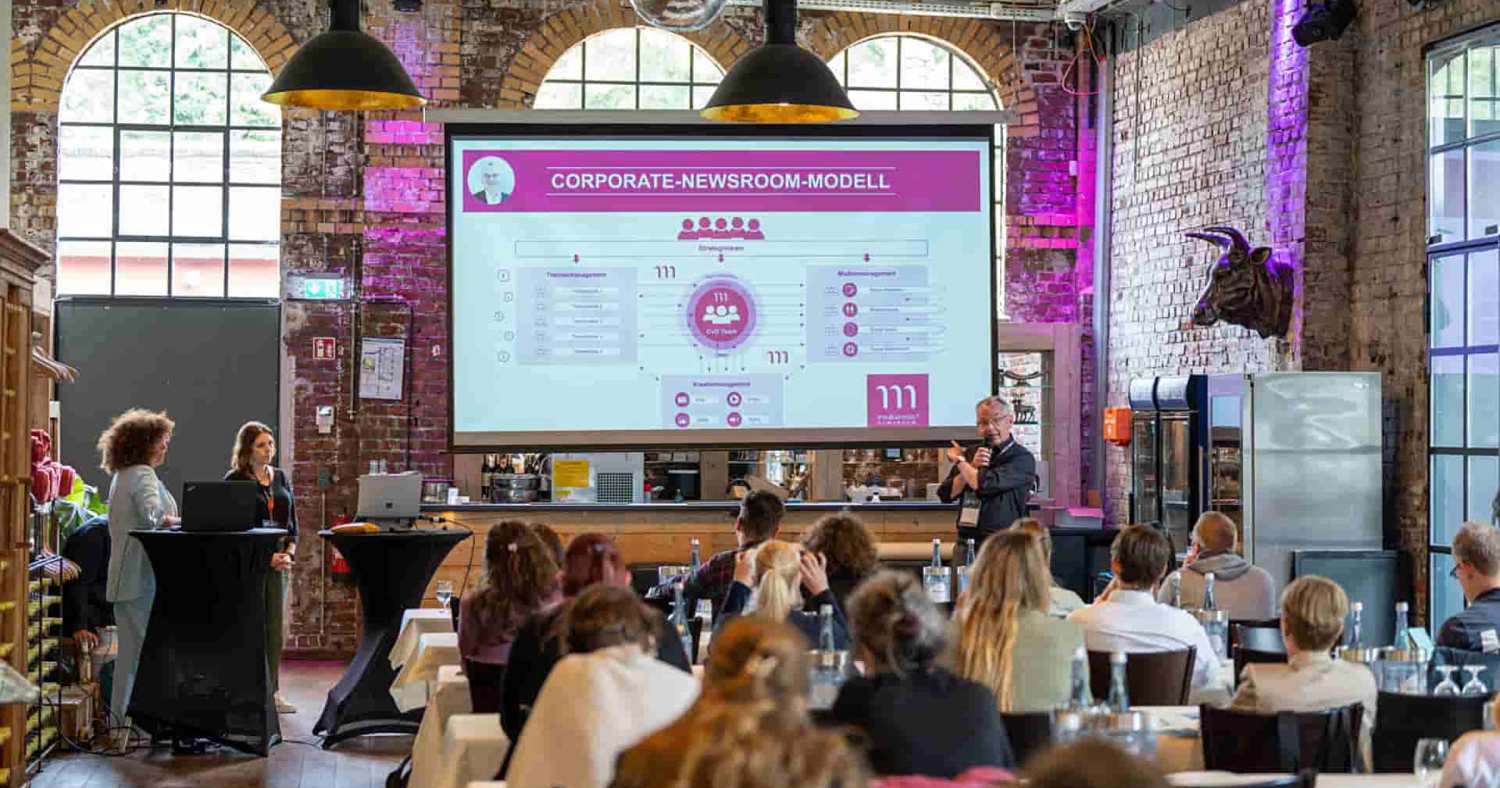


Write a comment
Your e-mail address will not be published. Required fields are marked with *.